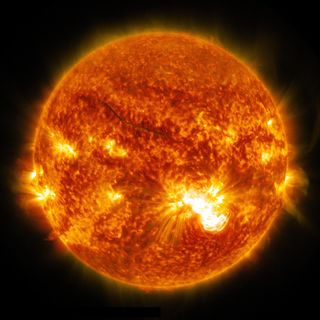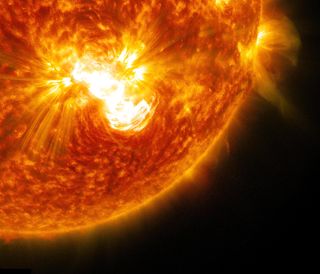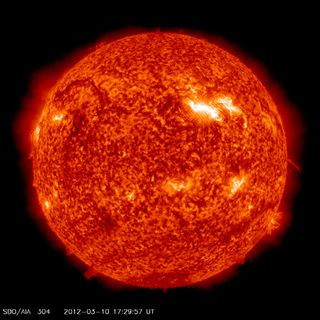Huge Solar Flare Erupts from Biggest Sunspot in 24 Years (Photos)
The biggest sunspot on the face of the sun in more than two decades unleashed a major flare on Friday (Oct. 24), the fourth intense solar storm from the active star in less than a week.

The solar flare occurred Friday afternoon, reaching its peak at 5:41 p.m. EDT (2141 GMT), and triggered a strong radio blackout at the time, according to the U.S. Space Weather Prediction Center. NASA's sun-watching Solar Dynamics Observatory captured stunning video of the huge solar flare.
The flare erupted from a giant active sunspot known as AR 12192 and was classified as an X3.1-class solar storm — one of the most powerful types of solar storms on the sun — but it is not the first time the sunspot has made its presence known. [Biggest Solar Flares of 2014 in Photos]
"This is the fourth substantial flare from this active region since Oct. 19," NASA spokesperson Karen Fox wrote in a status update.

Indeed, on Sunday (Oct. 19), the sunspot fired off a major X1.1-class solar flare, then followed it up with an intense M8.7-class flare on Wednesday (Oct. 22) that was followed that same day by an X1.6 event.

Sunspots are regions of the sun forged by shifting magnetic fields that are cooler than their surrounding solar material, giving them their dark, blemish-like appearance.
Sunspot AR 12192 dwarfs the Earth and is comparable to Jupiter in its size, according to solar astrophysicist C. Alex Young with NASA's Goddard Space Flight Center, who described the sunspot in his blog The Sun Today.
Get the Space.com Newsletter
Breaking space news, the latest updates on rocket launches, skywatching events and more!
The sunspot is the largest of its kind since November 1990, and is larger than a monster sunspot that spawned a series of major solar flares over Halloween in 2003, Young wrote.
And on Thursday (Oct. 23), the sunspot was hard to miss during a spectacular partial solar eclipse that was visible from North America. Many of the skywatchers who captured photos of the solar eclipse remarked on the surprising sight of a giant sunspot on the face of the sun.
"This was my first time photographing a solar eclipse and I was thrilled to capture the sunspots as well," skywatcher Mark Ezell of Austin, Texas, wrote in an email on Thursday.
X-class solar flares are the most powerful eruptions on the sun. When aimed directly at Earth, X-class flares can potentially pose a danger to astronauts and spacecraft in space, and interfere with navigation, radio and communications signals. M-class flares are ranked as moderate sun storms that can supercharge the Earth's aurora displays. There are also weaker classes of solar storms that have little effect on Earth, including C-class, B-class and even A-class storms.
"Solar flares are powerful bursts of radiation," Fox wrote in the NASA update. "Harmful radiation from a flare cannot pass through Earth's atmosphere to physically affect humans on the ground, however -- when intense enough -- they can disturb the atmosphere in the layer where GPS and communications signals travel."

"An X2 is twice as intense as an X1, an X3 is three times as intense, etc.," Fox wrote.
Despite its sheer power, the X3.1 solar flare on Friday was not the biggest sun storm of the year. On Feb. 24, the sun erupted with a monster X4.9-class solar flare that has topped the solar events of 2014. Smaller X-class flares have occurred occasionally throughout the year.
Young also wrote that sunspot AR 12192 is the largest sunspot of the sun's current 11-year weather cycle, known as Solar Cycle 24.
Email Tariq Malik at tmalik@space.com or follow him @tariqjmalik and Google+. Od-Original article on Space.com.
Join our Space Forums to keep talking space on the latest missions, night sky and more! And if you have a news tip, correction or comment, let us know at: community@space.com.

Tariq is the Editor-in-Chief of Space.com and joined the team in 2001, first as an intern and staff writer, and later as an editor. He covers human spaceflight, exploration and space science, as well as skywatching and entertainment. He became Space.com's Managing Editor in 2009 and Editor-in-Chief in 2019. Before joining Space.com, Tariq was a staff reporter for The Los Angeles Times covering education and city beats in La Habra, Fullerton and Huntington Beach. In October 2022, Tariq received the Harry Kolcum Award for excellence in space reporting from the National Space Club Florida Committee. He is also an Eagle Scout (yes, he has the Space Exploration merit badge) and went to Space Camp four times as a kid and a fifth time as an adult. He has journalism degrees from the University of Southern California and New York University. You can find Tariq at Space.com and as the co-host to the This Week In Space podcast with space historian Rod Pyle on the TWiT network. To see his latest project, you can follow Tariq on Twitter @tariqjmalik.









